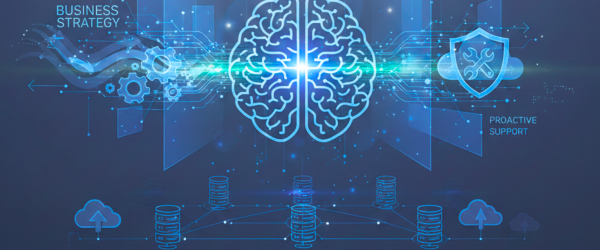Introduction
For many enterprises, Artificial Intelligence (AI) remains a collection of siloed projects: a predictive maintenance model here, a new customer service chatbot there. While these point solutions deliver value, they represent a fundamental misunderstanding of AI’s true potential. To thrive in the next decade, organizations must shift from treating AI as a feature to adopting an AI-First Mindset—a strategic philosophy where AI is the foundational layer of every IT decision and operational process.
The AI-First mindset recognizes that efficiency, security, and scalability are no longer achieved through manual human oversight or traditional automation tools, but through intelligent, autonomous systems. This isn’t just about investing in new tools; it’s about fundamentally transforming your operating model.
The Cost of the Status Quo: The Inefficiency Gap
The failure to adopt an AI-First strategy creates an ever-widening “Inefficiency Gap” between reactive and proactive enterprises. Modern complexity—from hybrid cloud sprawl to explosive data growth—is now beyond human manageability.
A recent report by Accenture highlights the urgency: Companies that integrate AI across their core business functions, including IT, are 3.5 times more likely to achieve superior growth compared to their peers (Accenture, 2024). This divergence confirms that AI is no longer a competitive advantage but a competitive necessity.
The Pillars of the AI-First IT Strategy
An AI-First strategy integrates intelligence across three critical areas, transforming reactive tasks into proactive, value-driven operations.
1. Strategic Decision-Making and Planning
An AI-First approach starts at the top, influencing capital expenditure, talent acquisition, and long-term planning.
- Predictive Portfolio Management: AI models analyze data from market trends, infrastructure capacity, and project success rates to recommend where to allocate IT budgets, ensuring investment is focused on high-ROI projects that align with business goals.
- Talent Strategy: IT leaders are using AI to identify skill gaps and project future needs, moving their teams away from manual maintenance towards high-value roles focused on engineering and strategic problem-solving. A survey by McKinsey found that early AI adopters are already seeing improved decision-making quality across functions like operations and marketing (McKinsey, 2023).
2. Autonomous and Efficient Operations (AIOps)
This is where the AI-First mindset delivers the most immediate, measurable ROI. It addresses the core pain points of complexity and cloud waste.
- Zero-Waste Cloud: AI replaces reactive auto-scaling with predictive optimization. By continuously analyzing workload patterns and forecasting demand spikes, AI provisions resources precisely when needed and scales them down instantly. Studies consistently show that companies leveraging AIOps for cloud optimization reduce their operational costs by 20-30% by eliminating over-provisioning (Gartner, 2023).
- Self-Healing Infrastructure: AI-powered systems monitor trillions of data points across logs and metrics. They detect anomalies that precede failures, diagnose the root cause instantaneously, and initiate automated remediation scripts—often resolving issues before users even notice an outage.
3. Hyper-Secure and Adaptive Defense
In the AI-First world, security is no longer a static perimeter but a continuously learning defense system.
- Behavioral Anomaly Detection: Traditional security relies on known signatures. AI establishes a baseline of “normal” user and network behavior, allowing it to instantly flag minute deviations that signal a zero-day attack or insider threat.
- Automated Threat Response: Upon identifying a high-fidelity threat, the AI-First system doesn’t wait for human approval; it automatically isolates the affected endpoint, revokes temporary credentials, and initiates containment, vastly improving Mean Time to Contain (MTTC).
Conclusion: The New IT Mandate
The argument for an AI-First IT strategy is fundamentally an argument for competitive resilience and superior financial performance. Organizations that persist with manual, reactive processes will inevitably struggle with increasing cloud complexity and rising operational costs.
AI is the new operating system for the enterprise. By embedding it into the core of their strategy, IT leaders can move beyond simple maintenance, transform their infrastructure into an autonomous intelligence, and secure a lasting advantage in the digital economy.







